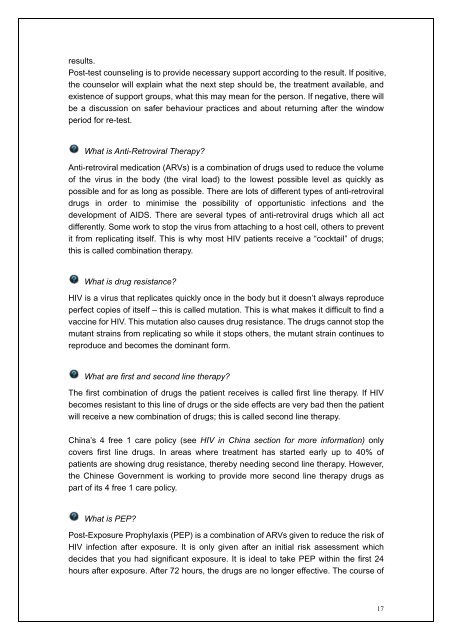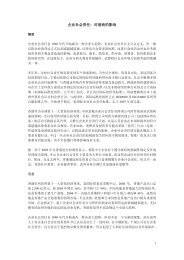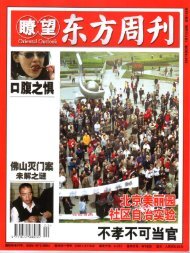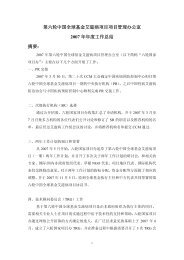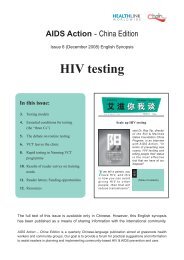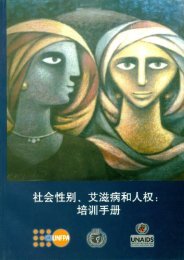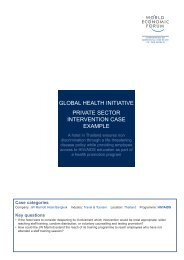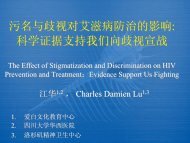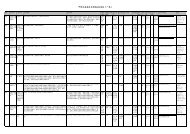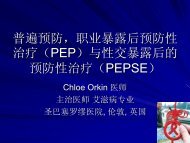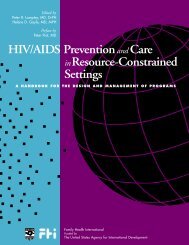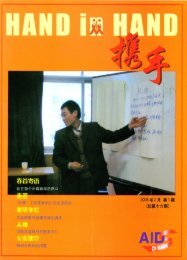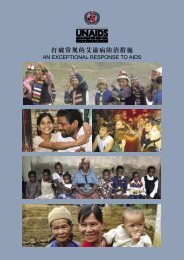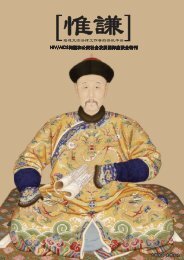What is HIV and AIDS?
What is HIV and AIDS?
What is HIV and AIDS?
Create successful ePaper yourself
Turn your PDF publications into a flip-book with our unique Google optimized e-Paper software.
esults.<br />
Post-test counseling <strong>is</strong> to provide necessary support according to the result. If positive,<br />
the counselor will explain what the next step should be, the treatment available, <strong>and</strong><br />
ex<strong>is</strong>tence of support groups, what th<strong>is</strong> may mean for the person. If negative, there will<br />
be a d<strong>is</strong>cussion on safer behaviour practices <strong>and</strong> about returning after the window<br />
period for re-test.<br />
<strong>What</strong> <strong>is</strong> Anti-Retroviral Therapy?<br />
Anti-retroviral medication (ARVs) <strong>is</strong> a combination of drugs used to reduce the volume<br />
of the virus in the body (the viral load) to the lowest possible level as quickly as<br />
possible <strong>and</strong> for as long as possible. There are lots of different types of anti-retroviral<br />
drugs in order to minim<strong>is</strong>e the possibility of opportun<strong>is</strong>tic infections <strong>and</strong> the<br />
development of <strong>AIDS</strong>. There are several types of anti-retroviral drugs which all act<br />
differently. Some work to stop the virus from attaching to a host cell, others to prevent<br />
it from replicating itself. Th<strong>is</strong> <strong>is</strong> why most <strong>HIV</strong> patients receive a “cocktail” of drugs;<br />
th<strong>is</strong> <strong>is</strong> called combination therapy.<br />
<strong>What</strong> <strong>is</strong> drug res<strong>is</strong>tance?<br />
<strong>HIV</strong> <strong>is</strong> a virus that replicates quickly once in the body but it doesn’t always reproduce<br />
perfect copies of itself – th<strong>is</strong> <strong>is</strong> called mutation. Th<strong>is</strong> <strong>is</strong> what makes it difficult to find a<br />
vaccine for <strong>HIV</strong>. Th<strong>is</strong> mutation also causes drug res<strong>is</strong>tance. The drugs cannot stop the<br />
mutant strains from replicating so while it stops others, the mutant strain continues to<br />
reproduce <strong>and</strong> becomes the dominant form.<br />
<strong>What</strong> are first <strong>and</strong> second line therapy?<br />
The first combination of drugs the patient receives <strong>is</strong> called first line therapy. If <strong>HIV</strong><br />
becomes res<strong>is</strong>tant to th<strong>is</strong> line of drugs or the side effects are very bad then the patient<br />
will receive a new combination of drugs; th<strong>is</strong> <strong>is</strong> called second line therapy.<br />
China’s 4 free 1 care policy (see <strong>HIV</strong> in China section for more information) only<br />
covers first line drugs. In areas where treatment has started early up to 40% of<br />
patients are showing drug res<strong>is</strong>tance, thereby needing second line therapy. However,<br />
the Chinese Government <strong>is</strong> working to provide more second line therapy drugs as<br />
part of its 4 free 1 care policy.<br />
<strong>What</strong> <strong>is</strong> PEP?<br />
Post-Exposure Prophylax<strong>is</strong> (PEP) <strong>is</strong> a combination of ARVs given to reduce the r<strong>is</strong>k of<br />
<strong>HIV</strong> infection after exposure. It <strong>is</strong> only given after an initial r<strong>is</strong>k assessment which<br />
decides that you had significant exposure. It <strong>is</strong> ideal to take PEP within the first 24<br />
hours after exposure. After 72 hours, the drugs are no longer effective. The course of<br />
17


